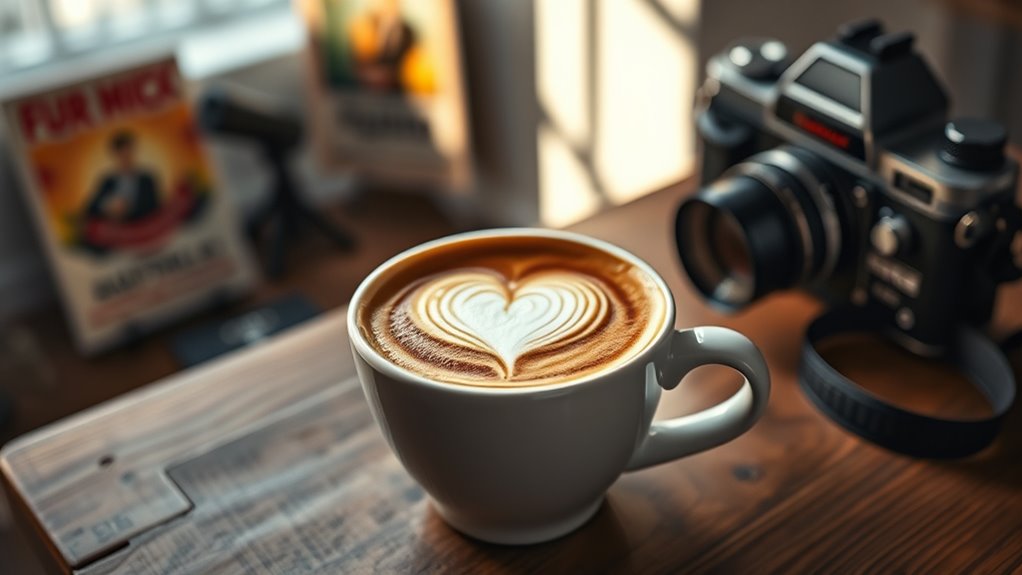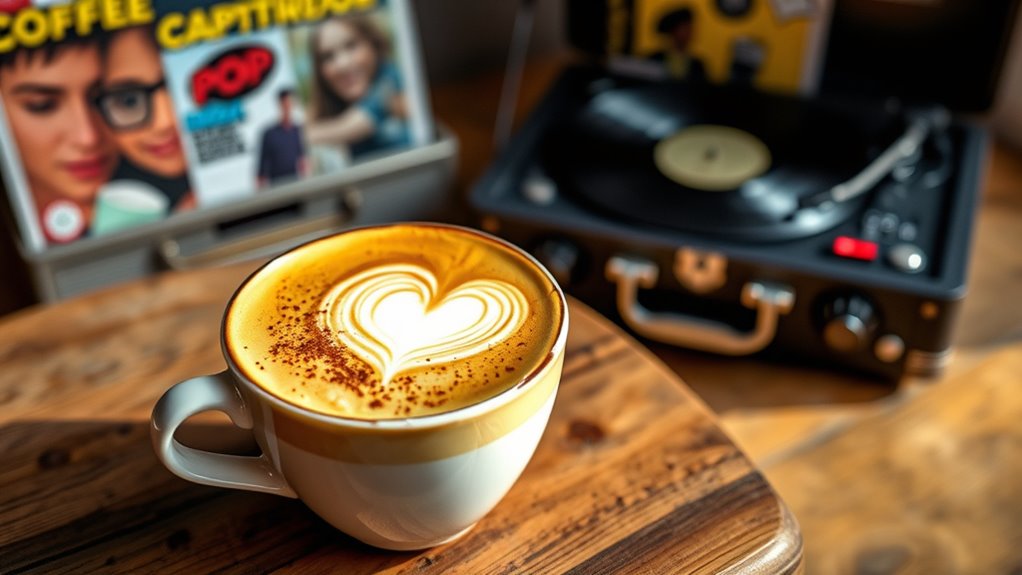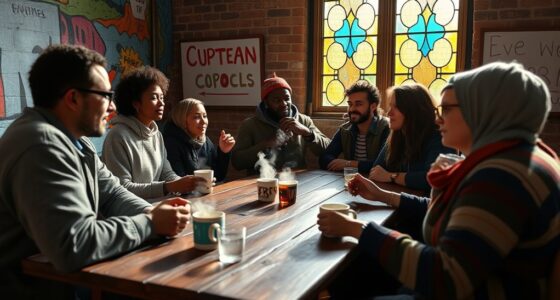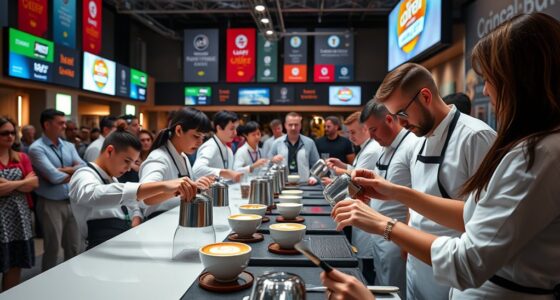Cappuccino in popular culture symbolizes much more than a coffee order; it reflects social intimacy, creative expression, and lifestyle trends. You’ll see it featured in movies, TV shows, and advertisements as a sign of sophistication or daily routine. It often represents a moment of connection or personal identity. If you keep exploring, you’ll discover how this frothy beverage continues to shape perceptions and inspire cultural imagery worldwide.
Key Takeaways
- Cappuccinos symbolize sophistication and modernity, often depicted in films as a sign of urban lifestyle and social status.
- In popular culture, cappuccino scenes evoke intimacy, relaxation, or social bonding, similar to other coffee moments in movies.
- The cappuccino’s aesthetic appeal, especially with foam art, makes it a visual icon in advertising and media.
- Cappuccinos are associated with café culture, representing creativity, community, and contemporary social rituals.
- Popular films and TV shows use cappuccino scenes to highlight character personalities, moods, or social settings.

Have you ever noticed how coffee, especially cappuccino, frequently appears in movies to symbolize tension, intimacy, or social interaction? This beverage isn’t just a drink; it’s a powerful visual and thematic device that helps filmmakers convey complex emotions and societal dynamics. In many film scenes, the presence of a cappuccino or other coffee drinks underscores moments of connection or conflict, making coffee a key element in the storytelling process. Whether it’s a quiet exchange over steaming mugs or a heated debate fueled by caffeine, coffee’s role in cinema highlights its status as a cultural icon within the broader coffee culture.
Cinematic coffee scenes often serve as more than mere background; they function as visual cues that reflect characters’ inner worlds or societal themes. For example, in *Five Easy Pieces*, Jack Nicholson’s struggle with a cup of coffee symbolizes personal tension and emotional conflict. Similarly, in *Heat*, a coffee break during a tense confrontation emphasizes the underlying stakes and the social interaction at play. These moments demonstrate how coffee symbolism extends beyond the beverage itself, becoming a shorthand for mood, character development, or social tension.
Coffee in movies is a universal motif that resonates across genres, emphasizing its significance in coffee and society. Moreover, coffee’s portrayal in films helps cement its place as a cornerstone of coffee culture and as a cultural icon. Iconic film moments involving coffee, like the famous diner scenes in *Pulp Fiction*, showcase how coffee in pop culture can symbolize camaraderie, routine, or even rebellion. These cinematic moments craft a shared visual language that elevates coffee from everyday beverage to a symbol of social interaction and cultural identity.
They reveal how coffee in movies acts as a bridge, connecting viewers to broader themes of human connection and societal values. Through these cinematic coffee scenes, audiences worldwide recognize the beverage’s role in shaping social narratives and cultural perceptions.
In essence, coffee in movies functions as a multifaceted symbol that captures the complexities of social interaction and societal norms. It’s more than a simple prop; it’s a visual and thematic tool that enhances storytelling. As a cultural icon, coffee’s appearance in film reminds us of its enduring significance in coffee culture and its power to symbolize intimacy, tension, and social cohesion.
Whether in quiet moments or intense exchanges, coffee’s cinematic presence continues to reflect its importance in our lives and in the stories we tell through film.
Frequently Asked Questions
What Is the Culture of Cappuccino?
You’re curious about the culture of cappuccino. It’s rooted in Italian tradition, where it’s a morning staple and symbolizes craftsmanship and social ritual.
You might notice how its presentation, like latte art, shows artistry and skill. Around the world, regions adapt it to local tastes, like Greece’s “freddo cappuccino.”
In modern times, it’s associated with café atmosphere, socializing, and appreciation for quality coffee.
When Did Cappuccino Become Popular in the USA?
You’re wondering when cappuccino became popular in the USA. It all started in the 1980s, with the rise of specialty coffee shops and espresso bars.
Starbucks, opening in 1971, helped introduce espresso drinks like cappuccino, and by the late 20th century, Americans embraced it as a symbol of European sophistication.
The growth of coffee chains and latte art made cappuccino a staple by the early 2000s.
Which Country Is Famous for Cappuccino?
You might think of Italy as the country most famous for cappuccino. They popularized the drink with their traditional 25ml espresso, topped with equal parts milk and foam, served in small cups before 11 am.
Italy’s rich coffee culture and the origins of the term “cappuccino” tie directly to its history and style. When you think of the classic cappuccino, Italy’s influence is what comes to mind first.
Why Don’t Italians Drink Cappuccino After 12 Pm?
You might wonder why Italians avoid drinking cappuccino after noon. They believe that milk-based drinks like cappuccino are too heavy for digestion later in the day, especially after lunch.
Italians typically reserve cappuccino for breakfast, preferring espresso for other times. Drinking it after 12 p.m. can seem unusual or inappropriate because it conflicts with their cultural emphasis on lighter, post-meal coffee.
Conclusion
You can see how cappuccino has become more than just a coffee choice; it’s a symbol in movies, music, and art. Its rich flavor and inviting foam make it a favorite for many. By now, you realize that cappuccino’s presence in popular culture influences trends and daily routines alike. So next time you sip one, remember you’re part of a global phenomenon that blends tradition, creativity, and community in every cup.









